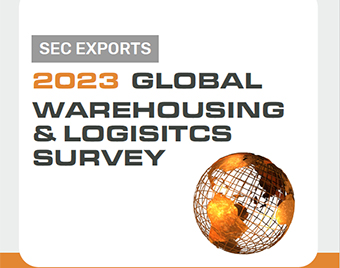2023 Global Warehousing & Logistics Survey
Discover insights from the 2023 Global Warehousing & Logistics Survey, highlighting trends, challenges, and innovations in supply chain management for industry professionals.
Open File
14.12.2022
Competition for warehouse space has pushed the demands to rise and commercial real estate cost across the UK has reached an all-time high. Several companies have agreed recently to pay 20% above the asking price. After Covid-19 disruptions, every participant in warehouse management has raised the issue of authenticity, responsible sourcing, and traceability. Lack of digital record keeping has introduce high chances of counterfeiting, distrust, and security risks among the distribution partners.
Blockchain has a huge potential to solve these operation challenges and operators are ready to adopt this technology in their warehouses. In the UK, at this point, only 11.3% of the Blockchain industry is focused on solving the supply chain and logistics problems. But MHI reports that the global adoption of blockchain to solve logistics and warehouse challenges would increase to 68% in the next five years.
Blockchain is essentially a decentralized ledger. That means it’s a network of interconnected computers or nodes that use a common protocol to validate and store the same information in a peer-to-peer(P2P) network. Every time there is an information update, it is transmitted in an encrypted form to every other node in the network to be validated before it is connected to the existing blockchain through a unique identifier. Once the update is successful there is no way to manipulate the information in the network. So, the data in the blockchain becomes decentralized, distributed, tokenized, encrypted, and immutable.

Blockchain allows warehouses, manufacturers, suppliers, production sites, distribution centres, and retail partners to connect to each other through a permanent digital record of every transaction that can be verified at every point. It provides end-to-end transparency that enables operators to see through consumer-level demand in real-time, allowing for better inventory management while planning for replenishment before the inventory is depleted.
Due to its tokenised nature, Blockchain technology allows for the implementation of “smart contracts,” which are computer programs that automatically execute an action according to a pre-determined set of rules simplifying transactions between warehouse operation members and offering an audit trail for those transactions. Digital records in the blockchain can also function as the bedrock of trust among the warehouse operation partners and customers because the data is immutable and highly secure due to the encrypted and distributed nature of blockchain technology.
Blockchain improves efficiency and brings down the cost of warehouse operations by introducing smart contracts which remove the need for paperwork and help automate inventory management tasks. The data in the blockchain increases the transparency and accuracy throughout the warehouse operations in real-time. The whole network within the warehouse has real-time access to the same up-to-date information about customer demand and parcel journey giving operators an edge to respond quickly when demand changes.
Blockchain not only streamlines the operations but takes care of the payments and refunds as payment tokens that optimize the capital deployment while making it possible for the operators to sell directly to retailers and customers accordingly when the demand forecast changes.


Discover insights from the 2023 Global Warehousing & Logistics Survey, highlighting trends, challenges, and innovations in supply chain management for industry professionals.
Open FileRobotics-as-a-service (RAAS) solves two problems facing many businesses today.
Read MoreWelcome to the world of seamless warehouse operations, where the introduction of Warehouse Management Systems (WMS) have revolutionised the way inventory is managed, tracked, and distributed.
Read More